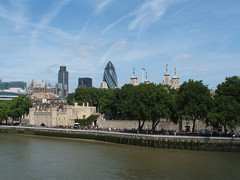Earlier this year, I started researching my family tree with my sister. I was something we’d both always wanted to do, but never told the other. When we both realised we wanted to do it, we found in the incentive to actually go about it. Things are much easier when you have someone else dragging you along…
As with most families I’d guess, there are various half remembered stories about great uncles or distant cousins that made good, died mysteriously or did something and were never spoken of again. The two best remembered stories in the family are quite good.
One involves either my great grandfather or his brother being an illegitimate son of one of the Mays from the Bryant and May match company. My Grandfather mentioned hearing about this when he was a kid, and there being quite a bit of money at stake should anyone ever be able to prove it. Of course it was never proven one way or the other when the money was still on the table, and there is no way to prove it now; the money is long gone anyway.
The other story is slightly more macabre. Again it involves my grandfather’s family. It seems that his father’s brother vanished in the first world war. Nothing too strange there, but it was later reported that he died on an ant hill in Africa and was stripped to the bone.
Well, now we are about 7 months into the research, we’ve traced back the immediate ancestors to around 1750 when they moved to the London area. Going back much further will probably be difficult and time consuming. So now we are starting to fill in the details of the lives of the people.
We visited the National Archives at Kew on Monday, to take a look at the army records from the first world war. Unfortunately, it seems that the majority of the records covering the time period we are interested in were destroyed during the bombing of London in the second world war.
We’ve been doing a bit of travelling around the East End, mainly Bow, Mile End and Hackney so we could see where the family has its roots. This should give me an excuse to post photos and maps and things…
The research has been fun and has expanded the number of living family members by around 50. Though these are all distant cousins, so apart from adding one or two the the xmas card list, I doubt we’ll have much further contact.
One good thing to come from all this has been discovering that on the whole, the family tends to long lives, aside from war and accidents, most of the menfolk make it to 70 with no problems, while the women get around another 10 years, even back in the 17 and 1800s.

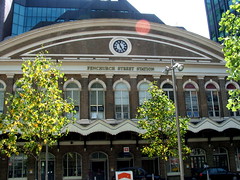 First port of call was Fenchurch Street station. Designed by George Berkeley, an engineer with the LTS and built in 1853-54 to serve the central London extention of the Blackwall railway as well as the London Tilbury Southend (LTS) line. The grey brick building has retained it’s Victorian charm over the years. It is however, rather less well known and used than some other mainline stations in London.
First port of call was Fenchurch Street station. Designed by George Berkeley, an engineer with the LTS and built in 1853-54 to serve the central London extention of the Blackwall railway as well as the London Tilbury Southend (LTS) line. The grey brick building has retained it’s Victorian charm over the years. It is however, rather less well known and used than some other mainline stations in London.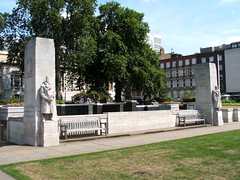 Heading away from the station towards the River and the Tower, the next interesting area is Trinity Square Gardens. This small public garden contains the site of the scaffold used for many executions on Tower Hill as well as the memorial to drowned and loster Fishermen and Sailors of the Merchant Navy (shown in the photo).
Heading away from the station towards the River and the Tower, the next interesting area is Trinity Square Gardens. This small public garden contains the site of the scaffold used for many executions on Tower Hill as well as the memorial to drowned and loster Fishermen and Sailors of the Merchant Navy (shown in the photo).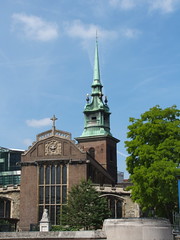 Turning 180 degrees from the monument in the gardens brings the impressive green copper spire of All Hallows by the Tower into view.
Turning 180 degrees from the monument in the gardens brings the impressive green copper spire of All Hallows by the Tower into view. 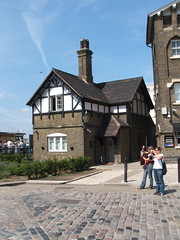 Wharfinger was an old term used to describe the supervisor of a river wharf.
Wharfinger was an old term used to describe the supervisor of a river wharf.